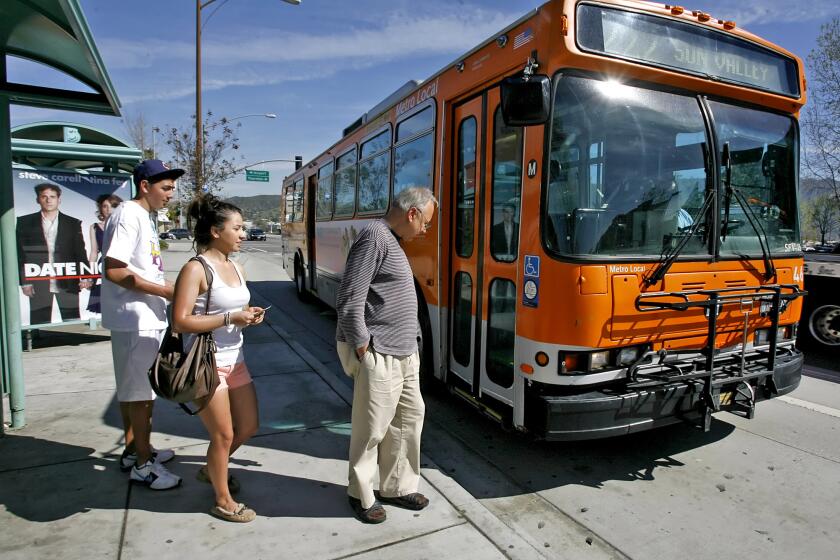The Cost of Using Child Safety Seats on Planes
Discount: Southwest offers a special fare for children under 2 years old.
On Nov. 1, Southwest Airlines became the first carrier to devise discount fares for children under 2 who travel in an automobile safety seat strapped into a passenger seat. Currently, children under 2 can travel free if they sit on a parent’s lap. But as airline accidents have tragically shown, babies can be easily thrust loose from their parents’ laps and hurt or killed.
The only real puzzle is why this discount involving safer flights for infants hasn’t been made available before. But if SB 1877, sponsored by Sen. Christopher Bond (R-Mo.), requiring the use of child-safety restraints for infants on domestic flights, is passed by Congress, there will probably be more discount offers.
Under the Southwest program, the infant fare provides discounts of up to 60% on economy fares. The infant fares range from $29 to $99 each way, depending on the cities involved. Proof of the child’s age, such as a birth certificate, is required.
“We didn’t create this fare as a revenue generator but as a low-cost alternative for adults who want to fly with their children under 2 in FAA approved car seats,” said Melanie Jones, a spokeswoman for Dallas-based Southwest Airlines. “Since we began offering the fare, we’ve carried about 400 children on this basis.”
The Federal Aviation Administration is considering a rule requiring airlines to allow the use of safety-restraint seats for toddlers. At present airlines aren’t officially required to permit passengers the option of using infant-restraint seats. However, carriers already accept FAA-approved infant child restraints. Any child-restraint seat manufactured after February, 1985 for use in cars can also be used on planes.
There is always the possibility that airlines would allow passengers to use an unoccupied seat for an infant at no charge. But even if such a seat became available, it might not be next to the adult and arranging adjacent seats might be unfeasible. The only way to ensure the availability of a seat in which to place a baby in a safety seat is to buy a ticket for the child.
Moreover, as child-restraint seats generally don’t fit in overhead racks or under seats, adults bringing such seats have to check them through as regular luggage if the carrier doesn’t have a vacant seat or won’t allow it to be used at no charge.
Meanwhile, other airlines have not followed Southwest’s move.
“Our position is that this is a matter for parental choice,” said Agnes Huff, a spokeswoman for USAir. “If a parent wants to be guaranteed use of a child-restraint seat for their infant, they have to buy a ticket for the baby. They can take a chance and bring the child restraint seat to the airport and if it’s determined at check-in or the gate that we have a vacant sea next to the adult’s seat we’ll let them use it for their child at no charge. But the seat has to be next to the passenger. We won’t move other passengers around. If there isn’t such a vacant seat available, the child-restraint seat would then be regarded as an over-sized carry-on item and be put in the plane’s baggage area.”
In some cases, however, airlines may allow the child-restraint seat to be brought aboard the plane. “We might allow passengers to board with a child restraint seat but we won’t switch passengers around unless the seats are very close, and it’s really a case-by-case situation,” said Joe Hopkins, a spokesman for United Airlines.
The pending legislation in Congress, however, may bring about a more systematic approach to the issue. The bill doesn’t require adults to buy seats for their infants, though that outcome is likely. “It would depend on how the airlines implement such a law,” said David Ayres, a spokesman for Bond.
Bond contends that the airlines’ economic interest is to keep families flying, so they will make sure families with infants can afford to fly. “Safety does have a cost, but the lack of safety carries the highest cost of all--loss of life. On an airline flight today, everything from coffee pots to corpses must be secured before takeoff--everything except infants and toddlers. How can we deny our children the same protection we give ourselves?”
A similar bill by Bond passed the Senate last year but was defeated in the House of Representatives. “We expect to get it through the Senate again in 1992, but we’re not sure about the House,” Ayres said. “Most people are in favor of the bill, but the FAA has opposed it in the past.”
The Air Transport Assn., the industry group representing domestic airlines, has come out in favor of mandatory use of child-restraint seats for infants on flights. “We support the bill,” said Bill Jackman, a spokesman for the ATA. “The FAA has a problem with the cost effectiveness of such a rule . . . but we feel it’s time for such a requirement. If adults buckle children up when driving their cars at 55 m.p.h., they should be required to also do so on planes flying at 550 m.p.h.”
Passage of such a law would probably lead to competition between the airlines on how to handle implementation, Jackman added.
The Association of Flight Attendants has also criticized the FAA proposal for not making it mandatory for infants to wear child restraints during flights. “This is one of the issues that airlines, passengers and flight crews all agree on,” said Matt Finucane, a spokesman for the group. “It’s ironic that the FAA should oppose it as they have the statutory obligation to protect passengers of all ages. The FAA has this opportunistic argument that travelers might switch to car travel if they had to pay for a seat for infants on flights, and that car travel is less safe..
While the FAA encourages parents to use safety seats for their children, it is still opposed at this time to mandatory use of child safety seats, according to Elly Brekke, a FAA spokeswoman.
In testimony July 12, 1990 before a House subcommittee, the FAA said: “While the chances of survival aboard an airplane may be slightly improved, the costs associated with mandating the carriage of a child in a separate seat will divert a significant number of families from our safest form of transportation--air travel--to the far less safe travel by automobile.”
Sign up for The Wild
We’ll help you find the best places to hike, bike and run, as well as the perfect silent spots for meditation and yoga.
You may occasionally receive promotional content from the Los Angeles Times.



